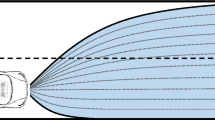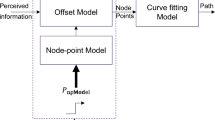Abstract
A model predictive control (MPC)-based shared steering framework for intelligent vehicles is proposed in this paper. The road boundary and vehicle stability boundary are regarded as the safe envelope, and the tradeoff between the freedom of driver operation and safety assurance of intelligent vehicles is made within this safe envelope. Under this cooperative steering framework, the reliability of drivers is analyzed in dangerous situations and in the predictive time domain, and two improved schemes are proposed. Under the two improved schemes, the weight of the control objective can be adaptively changed according to the results of the threat assessment and predetermined strategy. At the same time, an evaluation index named control intervention rate and risk rate is proposed to evaluate the designed human-vehicle cooperation scheme. The simulation results show that the performance of the two improved schemes in ensuring the safety of intelligent vehicles has been improved.
Similar content being viewed by others
References
Veres S M, Molnar L, Lincoln N K, et al. Autonomous vehicle control systems - a review of decision making. Proc Inst Mech Eng Part I-J Syst Control Eng, 2011, 225: 155–195
Dixit S, Fallah S, Montanaro U, et al. Trajectory planning and tracking for autonomous overtaking: state-of-the-art and future prospects. Annu Rev Control, 2018, 45: 76–86
Hu C, Wang Z F, Taghavifar H, et al. MME-EKF-based path-tracking control of autonomous vehicles considering input saturation. IEEE Trans Veh Technol, 2019, 68: 5246–5259
Hu C, Chen Y M, Wang J M. Fuzzy observer-based transitional path-tracking control for autonomous vehicles. IEEE Trans Intell Transport Syst, 2020. doi: https://doi.org/10.1109/TITS.2020.2979431
van Brummelen J, O’Brien M, Gruyer D, et al. Autonomous vehicle perception: the technology of today and tomorrow. Transp Res Part C-Emerg Technol, 2018, 89: 384–406
Schoettle B, Sivak M. A Preliminary Analysis of Real-world Crashes Involving Self-driving Vehicles. The University of Michigan Transportation Research Institute Report UMTRI-2015-34. 2015
Schoettle B, Sivak M. Public Opinion About Self-driving Vehicles in China, India, Japan, the US, the UK, and Australia. The University of Michigan Transportation Research Institute Report UMTRI-2014-30. 2014
Mars F, Chevrel P. Modelling human control of steering for the design of advanced driver assistance systems. Annu Rev Control, 2017, 44: 292–302
Mars F, Deroo M, Hoc J M. Analysis of human-machine cooperation when driving with different degrees of haptic shared control. IEEE Trans Haptics, 2014, 7: 324–333
Kim J H, Song J B. Control logic for an electric power steering system using assist motor. Mechatronics, 2002, 12: 447–459
van der Wiel D W J, van Paassen M M, Mulder M, et al. Driver adaptation to driving speed and road width: exploring parameters for designing adaptive haptic shared control. In: Proceedings of IEEE International Conference on Systems, Man, and Cybernetics, Kowloon, 2015. 3060–3065
Abbink D A, Mulder M, van der Helm F C T, et al. Measuring neuromuscular control dynamics during car following with continuous haptic feedback. IEEE Trans Syst Man Cybern B, 2011, 41: 1239–1249
Abbink D A, Cleij D, Mulder M, et al. The importance of including knowledge of neuromuscular behaviour in haptic shared control. In: Proceedings of IEEE International Conference on Systems, Man, and Cybernetics (SMC), Seoul, 2012. 3350–3355
Iwano K, Raksincharoensak P, Nagai M. A study on shared control between the driver and an active steering control system in emergency obstacle avoidance situations. IFAC Proc Volumes, 2014, 47: 6338–6343
Boink R, van Paassen M M, Mulder M, et al. Understanding and reducing conflicts between driver and haptic shared control. In: Proceedings of IEEE International Conference on Systems, Man, and Cybernetics (SMC), San Diego, 2014. 1510–1515
Do M T, Man Z H, Zhang C S, et al. Robust sliding mode-based learning control for steer-by-wire systems in modern vehicles. IEEE Trans Veh Technol, 2014, 63: 580–590
Brandt T, Sattel T, Bohm M. Combining haptic human-machine interaction with predictive path planning for lane-keeping and collision avoidance systems. In: Proceedings of IEEE Intelligent Vehicles Symposium, Istanbul, 2007. 582–587
Mulder M, Abbink D A, Boer E R. Sharing control with haptics: seamless driver support from manual to automatic control. Hum Factors, 2012, 54: 786–798
Switkes J P, Rossetter E J, Coe I A, et al. Handwheel force feedback for lanekeeping assistance: combined dynamics and stability. J Dyn Syst Meas Control, 2006, 128: 532–542
Petermeijer S M, Abbink D A, de Winter J C F. Should drivers be operating within an automation-free bandwidth? Evaluating haptic steering support systems with different levels of authority. Hum Factors, 2015, 57: 5–20
Na X, Cole D J. Game-theoretic modeling of the steering interaction between a human driver and a vehicle collision avoidance controller. IEEE Trans Human-Mach Syst, 2015, 45: 25–38
Well K. Aircraft control laws for envelope protection. In: Proceedings of AIAA Guidance, Navigation, and Control Conference and Exhibit, Keystone, 2006. 258–267
Erlien S M, Funke J, Gerdes J C. Incorporating non-linear tire dynamics into a convex approach to shared steering control. In: Proceedings of American Control Conference, Portland, 2014. 3468–3473
Erlien S M, Fujita S, Gerdes J C. Shared steering control using safe envelopes for obstacle avoidance and vehicle stability. IEEE Trans Intell Transp Syst, 2016, 17: 441–451
Salvucci D D, Gray R. A two-point visual control model of steering. Perception, 2004, 33: 1233–1248
Nguyen A T, Sentouh C, Popieul J C. Driver-automation cooperative approach for shared steering control under multiple system constraints: design and experiments. IEEE Trans Ind Electron, 2017, 64: 3819–3830
Li R J, Li Y N, Li S B, et al. Driver-automation indirect shared control of highly automated vehicles with intention-aware authority transition. In: Proceedings of IEEE Intelligent Vehicles Symposium (IV), Redondo Beach, 2017. 26–32
Plöchl M, Edelmann J. Driver models in automobile dynamics application. Veh Syst Dyn, 2007, 45: 699–741
Biondi F, Alvarez I, Jeong K A. Human-vehicle cooperation in automated driving: a multidisciplinary review and appraisal. Int J Human-Comput Inter, 2019, 35: 932–946
Johns M, Mok B, Sirkin D, et al. Exploring shared control in automated driving. In: Proceedings of the 11th ACM/IEEE International Conference on Human-Robot Interaction (HRI), Christchurch, 2016. 91–98
Nishimura R, Wada T, Sugiyama S. Haptic shared control in steering operation based on cooperative status between a driver and a driver assistance system. J Human-Robot Inter, 2015, 4: 19–37
Tan D K, Chen W W, Wang H B, et al. Shared control for lane departure prevention based on the safe envelope of steering wheel angle. Control Eng Practice, 2017, 64: 15–26
Saleh L, Chevrel P, Claveau F, et al. Shared steering control between a driver and an automation: stability in the presence of driver behavior uncertainty. IEEE Trans Intell Transp Syst, 2013, 14: 974–983
Wang W S, Xi J Q, Liu C, et al. Human-centered feed-forward control of a vehicle steering system based on a driver’s path-following characteristics. IEEE Trans Intell Transp Syst, 2017, 18: 1440–1453
MacAdam C C. An optimal preview control for linear systems. J Dyn Syst Meas Control, 1980, 102: 188–190
Du H P, Zhang N, Dong G M. Stabilizing vehicle lateral dynamics with considerations of parameter uncertainties and control saturation through robust yaw control. IEEE Trans Veh Technol, 2010, 59: 2593–2597
Shen C, Shi Y, Buckham B. Integrated path planning and tracking control of an AUV: a unified receding horizon optimization approach. IEEE/ASME Trans Mechatron, 2017, 22: 1163–1173
Zhou L M, Jia L, Wang Y L. A robust integrated model predictive iterative learning control strategy for batch processes. Sci China Inf Sci, 2019, 62: 219202
Guo L L, Chen H, Gao B Z, et al. Energy management of HEVs based on velocity profile optimization. Sci China Inf Sci, 2019, 62: 089203
Felipe E, Navin F. Automobiles on horizontal curves: experiments and observations. Transp Res Record, 1998, 1628: 50–56
Bella F. Driver perception of roadside configurations on two-lane rural roads: effects on speed and lateral placement. Accid Anal Prev, 2013, 50: 251–262
Acknowledgements
This work was supported by National Natural Science Foundation of China (Grant Nos. U19A2069, 61790563, U1664263), Project of the Education Department of Jilin Province (Grant No. JJKH20190165KJ), and Project of Development and Reform Commission of Jilin Province (Grant No. 2019C036-5).
Author information
Authors and Affiliations
Corresponding author
Rights and permissions
About this article
Cite this article
Liu, J., Guo, H., Song, L. et al. Driver-automation shared steering control for highly automated vehicles. Sci. China Inf. Sci. 63, 190201 (2020). https://doi.org/10.1007/s11432-019-2987-x
Received:
Revised:
Accepted:
Published:
DOI: https://doi.org/10.1007/s11432-019-2987-x




